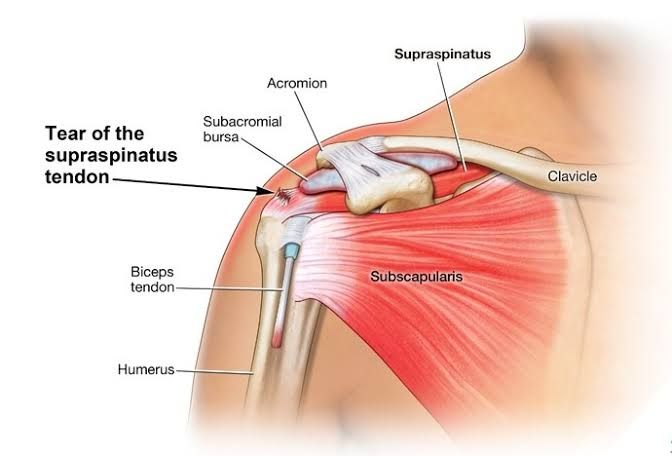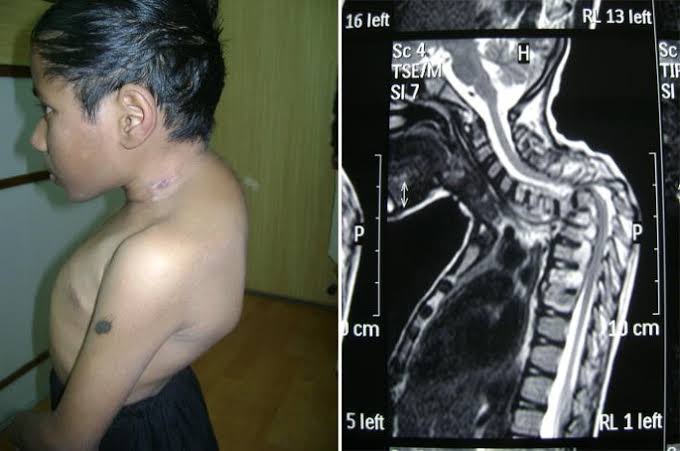
Rotator Cuff Tear
Anatomy of the Shoulder
The shoulder is a ball-and-socket joint composed of three bones: the humerus (upper arm bone), the scapula (shoulder blade), and the clavicle (collarbone). The head of the humerus fits into a shallow socket in the shoulder blade. The rotator cuff, a group of four muscles and their tendons, forms a covering around the head of the humerus, attaching it to the shoulder blade. These muscles are crucial for lifting and rotating the arm. A lubricating sac called a bursa lies between the rotator cuff and the acromion (the bone on top of the shoulder), allowing the tendons to glide freely during arm movement.
Description of Rotator Cuff Tears
A rotator cuff tear occurs when one or more of the rotator cuff tendons is torn, leading to partial or complete detachment from the head of the humerus. The most commonly affected tendon is the supraspinatus tendon. Tears can be categorized into:
- Partial Tear: The tendon is not completely detached from the bone, but it is thinner than normal due to a tear that goes only partially through the tendon’s thickness.
- Full-Thickness Tear: The tendon is detached from the bone. This can be further classified as:
- Full-Thickness Incomplete Tear: Only a small part of the tendon is detached.
- Full-Thickness Complete Tear: The tendon is completely detached, resulting in a hole in the tendon.
Causes of Rotator Cuff Tears
There are two main causes of rotator cuff tears:
- Injury-Related (Acute) Tear: This type of tear can result from a fall onto an outstretched arm, lifting a heavy object with a jerking motion, or other injuries such as a broken collarbone, dislocated shoulder, or wrist fracture.
- Wear-Related (Degenerative) Tear: Most tears are due to the gradual wearing down of the tendon over time, which is a natural process of aging. These tears are often painless initially but can become symptomatic over time. Factors contributing to degenerative tears include:
- Repetitive Stress: Activities that involve repetitive shoulder motions, such as baseball, tennis, rowing, and weightlifting, can stress the rotator cuff muscles and tendons. Jobs and chores that involve overhead work can also contribute.
- Lack of Blood Supply: As people age, the blood supply to the rotator cuff tendons decreases, impairing the body’s ability to repair tendon damage, which can lead to tears.
Risk Factors
Rotator cuff tears are more common in individuals over 40 due to the natural wear and tear associated with aging. People who engage in repetitive lifting or overhead activities are at higher risk. Athletes, particularly those in sports like tennis and baseball, as well as individuals in occupations such as painting and carpentry, are more susceptible to overuse tears. While overuse tears can occur in younger people, most tears in young adults are caused by traumatic injuries.
Symptoms
Common symptoms of a rotator cuff tear include:
- Pain at rest and at night, particularly if lying on the affected shoulder.
- Pain when lifting and lowering the arm or with specific movements.
- Weakness and difficulty with routine activities such as combing hair or reaching behind the back.
- A crackling sensation (crepitus) when moving the shoulder in certain positions.
Diagnosis and Treatment
A healthcare provider will perform a physical exam to assess shoulder tenderness, range of motion, and arm strength. To confirm the diagnosis, imaging tests such as X-rays, MRI, or ultrasound may be used.
Treatment options for rotator cuff tears include:
- Nonsurgical Treatment: Rest, pain relievers, and physical therapy can help manage symptoms and improve function. Corticosteroid injections may be used to reduce inflammation and pain.
- Surgical Treatment: In cases where nonsurgical treatments fail or in the presence of a complete tear, surgery may be necessary to reattach the torn tendon to the bone. Surgical options include arthroscopic repair or open surgery.
Prevalence and Impact
Rotator cuff tears are a common cause of shoulder pain and disability, affecting nearly 2 million people in the U.S. annually. These tears can significantly impact daily activities, making tasks like getting dressed or combing hair painful and difficult. The prevalence of rotator cuff tears increases with age, and many individuals may have asymptomatic tears.
Impingement Syndrome
Definition and Overview
Impingement syndrome, also known as shoulder impingement syndrome, is a common condition characterized by the pinching or rubbing of the rotator cuff tendons and bursa in the shoulder against the bones of the shoulder joint. This occurs primarily when there is swelling or inflammation that causes these structures to become too large to fit comfortably within the limited space between the humerus (the upper arm bone) and the acromion (the outer edge of the shoulder blade).
Causes
The primary cause of impingement syndrome is repetitive overhead activities that place stress on the shoulder joint. This can occur in various scenarios, such as during sports (e.g., swimming, tennis) or physical labor jobs that require lifting or reaching overhead. Over time, these repetitive motions can lead to inflammation of the rotator cuff tendons (tendinitis) and bursae (bursitis), which may result in pain and restricted movement.
Symptoms
Individuals with impingement syndrome typically experience persistent shoulder pain that may worsen with specific movements, particularly those involving raising the arm overhead or reaching behind the back. Common symptoms include:
- Pain located at the front of the shoulder
- Difficulty performing overhead tasks
- Weakness in shoulder muscles
- Pain during activities such as putting on a coat or reaching for objects
If left untreated, chronic impingement can lead to more severe conditions such as rotator cuff tears, resulting in significant weakness and further limitations in mobility.
Diagnosis
Diagnosis begins with a thorough medical history and physical examination conducted by a healthcare provider. The provider will assess range of motion and may perform specific tests to elicit pain associated with impingement. Imaging tests like X-rays may be utilized to rule out other conditions such as arthritis or fractures and to identify any bone spurs or abnormalities contributing to impingement.
Treatment Options
Treatment for impingement syndrome generally starts conservatively with:
- Medications: Nonsteroidal anti-inflammatory drugs (NSAIDs) like ibuprofen or naproxen are commonly prescribed to reduce inflammation and alleviate pain.
- Physical Therapy: A physical therapist may guide patients through exercises aimed at strengthening shoulder muscles and improving flexibility.
- Activity Modification: Patients are advised to avoid repetitive overhead activities that exacerbate symptoms.
- Corticosteroid Injections: If symptoms persist despite conservative treatment, corticosteroid injections may be considered to provide temporary relief from inflammation.
In cases where conservative measures fail after an extended period, surgical options such as arthroscopic decompression may be recommended to create more space for the rotator cuff by removing part of the acromion.
Biceps Tendinitis, Deltoid Contracture, Olecranon Bursitis, and Carpal Tunnel Syndrome
1. Biceps Tendinitis
Biceps tendinitis, also known as biceps tendonitis, is characterized by inflammation of the long head of the biceps tendon, which connects the biceps muscle to the shoulder. This condition often arises from overuse or repetitive overhead motions, making athletes—particularly baseball players, swimmers, and tennis players—more susceptible. Symptoms typically include pain and tenderness in the front of the shoulder, which may worsen with physical activity or lifting the arm overhead. Patients may also experience a snapping sensation in the shoulder.
Treatment usually begins conservatively with rest, ice application, and anti-inflammatory medications. If symptoms persist despite conservative management, surgical intervention may be necessary. Surgical options can include arthroscopic procedures to repair or remove damaged tissue.
2. Deltoid Contracture
Deltoid contracture refers to a condition where there is a shortening or tightening of the deltoid muscle, which can lead to restricted movement in the shoulder joint. This condition can occur due to prolonged immobilization after an injury or surgery, resulting in stiffness and limited range of motion. Patients may experience pain when attempting to lift their arms or perform overhead activities.
Management typically involves physical therapy focused on stretching and strengthening exercises to restore mobility and function. In severe cases where conservative treatment fails, surgical release of the contracted muscle may be considered.
3. Olecranon Bursitis
Olecranon bursitis is an inflammation of the bursa located at the tip of the elbow (olecranon). It can result from trauma (such as falling on the elbow), prolonged pressure (like resting on hard surfaces), or infection. Symptoms include swelling at the back of the elbow, pain during movement, and sometimes redness if infection is present.
Treatment generally involves rest and avoiding aggravating activities. Ice application can help reduce swelling. In cases where bursitis is caused by infection or does not improve with conservative measures, aspiration (removal of fluid) or corticosteroid injections may be necessary. Surgery might be required for chronic cases that do not respond to other treatments.
4. Carpal Tunnel Syndrome
Carpal tunnel syndrome occurs when there is compression of the median nerve as it travels through a narrow passageway in the wrist called the carpal tunnel. This condition often results from repetitive hand movements or conditions such as diabetes or rheumatoid arthritis. Symptoms typically include numbness, tingling, and weakness in the hand and fingers.
Initial treatment focuses on reducing inflammation through rest and splinting of the wrist. Nonsteroidal anti-inflammatory drugs (NSAIDs) may also be used for pain relief. If symptoms persist despite conservative management, surgical intervention might be necessary to relieve pressure on the median nerve by cutting through ligaments that are constricting it.
Classification of Impingement Syndrome, Trigger Finger, Hallux Valgus, Hammer Toe, Claw Toes
1. Impingement Syndrome
Impingement syndrome is primarily classified into two types based on the anatomical structures involved:
- Subacromial Impingement Syndrome (SIS): This occurs when the rotator cuff tendons are compressed under the acromion during shoulder movements.
- Internal Impingement: This involves the interaction between the rotator cuff and the glenoid labrum or posterior aspect of the shoulder joint.
2. Trigger Finger
Trigger finger is classified based on its severity and symptoms:
- Grade 1: The finger can be moved freely but may catch occasionally.
- Grade 2: The finger catches more frequently but can still be straightened with some effort.
- Grade 3: The finger is locked in a bent position but can be straightened with assistance.
- Grade 4: The finger remains locked in a bent position and cannot be straightened without surgical intervention.
3. Hallux Valgus
Hallux valgus is classified based on its severity using angles measured on X-rays:
- Mild (Angle < 20 degrees): Minimal deformity with little to no symptoms.
- Moderate (Angle 20-40 degrees): Noticeable deformity with moderate symptoms affecting daily activities.
- Severe (Angle > 40 degrees): Significant deformity causing severe pain and functional impairment.
4. Hammer Toe
Hammer toe classification typically considers the affected joint’s position:
- Flexible Hammer Toe: The toe can still be moved at the proximal interphalangeal joint (PIPJ).
- Rigid Hammer Toe: The toe is fixed in a bent position at the PIPJ and cannot be straightened.
5. Claw Toes
Claw toes are classified based on their presentation:
- Flexible Claw Toes: The joints can still move, but there is an abnormal posture.
- Rigid Claw Toes: The joints are fixed in a clawed position, leading to significant discomfort and functional limitations.
Conclusion
- Impingement Syndrome: a condition where a tendon or ligament becomes pinched or compressed, causing pain and inflammation.
- Trigger Finger: a condition where the tendon that controls the movement of the finger becomes inflamed, causing the finger to catch or lock when extended.
- Hallux Valgus: a condition where the big toe becomes misaligned, causing pain and discomfort.
- Hammer Toe: a condition where the toe becomes bent or curled, causing pain and discomfort.
- Claw Toes: a condition where the toe becomes bent or curled, causing pain and discomfort.







